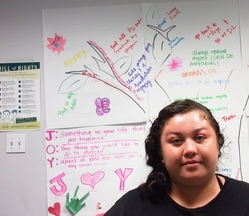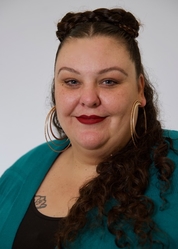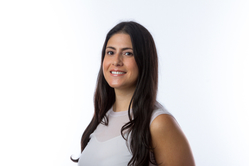YWFC sponsored Sister Warriors meeting
When she was 15 years old, Lucero Herrera was put in a rehab program by San Francisco’s Juvenile Court because she was getting drunk regularly. And in doing so, the court failed to explore the root of her drinking. Had they done so, she said, they would have found that anger and trauma were lurking underneath, driven by her ACEs: adverse childhood experiences.

"Why did they put me in a drug program when I had an anger problem? I went through a lot of violence, and they still didn’t find a way for me to heal,” says Herrera, who is now the program manager of detention and reentry with the San Francisco-based Young Women’s Freedom Center (YWFC), an advocacy organization started in 1993 by women and girls who were formerly incarcerated.
“Drinking wasn’t my problem. Being bullied was a problem. My mom putting so much responsibility on me was a problem. Me growing up without a dad was a problem. Me having to watch violent things happening to my brother. These were the things causing the anger and they weren’t looking at that,” says Herrera.
Herrera was reflecting on the connections between her personal experiences of trauma and violence and the impact of the juvenile justice system on her life as a participant/researcher for a report recently released by the Young Women’s Freedom Center. The report puts front and center the trauma and adversity underlying the experiences of women, girls, women and transgender non-conforming people who have been involved in the juvenile and criminal justice systems and foster care. It also lays bare how these systems further traumatized them and how racism fuels the systems. The report recommends changes to move these systems on a road towards healing rather than continued harming.
And significantly, the research mirrors the leadership model of YWFC — that those most impacted by systems are the experts. As such, Herrera and her peers developed the questions and areas to explore. And participants weighed in by providing suggestions for edits.

“Our long-term focus is to expand our collective capacity to use critical, participatory research as a tool for social transformation,” wrote YWFC Executive Director Jessica Nowlan.
Work for the report, “A Radical Model for Decriminalization,” began in 2017 and involved 100 participants, mostly people of color, between the ages of 18 and 29. The data itself paints a stark picture, but the research also included life stories that capture nuance often missing from data alone. Some 52 % of mothers and 68% of fathers had been incarcerated. (See the uploaded report below.)
The participants who had been in one or more of the foster care, juvenile or adult justice systems were asked to count up how many different places “they laid their heads at night,” including apartments, houses, streets, night-to-night hotels, cars, the justice system, foster care, and any other institutional setting. The answer: More than 20 times on average for participants between the ages of 13 and 17 and an average of 16. 8 times for participants between the ages of 18 and 21. All of the participants took the 10-question survey from the CDC-Kaiser Permanente Adverse Childhood Experiences Study(ACE Study). The average score was 6.5, and if participants had been in all three systems, the average score was 7.6. The ACE score results, noted the report, were consistent with research “that has looked at trauma as one of the predominate pathways to incarceration.”
The ACE Study showed a remarkable link between 10 types of childhood trauma — such as witnessing a mother being hit, living with a family member who is addicted to alcohol or who is mentally ill, living with a parent who is emotionally abusive, experiencing divorce — and the adult onset of chronic disease, mental illness, being violent or a victim of violence, among many other consequences. The study found that two-thirds of the more than 17,000 participants, who were mostly white, had an ACE score of at least one, and 12 percent had an ACE score of four or more. (For more information, see ACEs Science 101.) Subsequent ACE questionnaires include experiencing bullying, the foster care system, losing a family member to deportation and being a war refugee, among other traumatic experiences.
The ACE Study is part of ACEs science, which comprises ACE surveys, how toxic stress from trauma caused by ACEs can damage children’s developing brains, how toxic stress from ACEs affects health, how toxic stress can be passed from generation to generation, and, most important, how the brain and body can heal.
Participants were asked to fill out the original 10-question ACE survey after telling their life stories, says YWFC’s Research Director Alezandra Melendrez. Their responses revealed some of the limitations of the original survey in capturing their experiences.

“People had so many different settings in which they experienced ACEs….The ACE survey presumes you have one house. What if you’re a ward of the state?” asks Melendrez, as one example. “What does trauma look like if it's a parent doing it or a probation officer, or whether it’s in a group home, or if you’re criminalized for stealing diapers?”
Capturing the stories of the participants lives displayed layers that the data doesn’t reveal. For example, black and Latinx participants reported on average that they were suspended 6.9 and 6.3 times, respectively, for getting into a fight or not listening to a teacher. They spoke about how they felt targeted because of their race, according to the report, a finding echoed by other data on school suspensions. And researchers helped guide them to the core of what was happening in their lives at the times that they were punished. “It sounds like when you were getting suspended you were homeless,” was a question asked of one participant, according to Melendrez, which prompted the participant to reflect, “I was in a shelter at the time.”
And the guided interviews revealed other connections that are often missed by those in a position to help, such as having an incarcerated parent and difficulty concentrating, having to change foster care homes and exhibiting anger at school, having to meet with probation officers and missing school, entering the juvenile justice system because they had committed crimes associated with trying to survive.
“The vast majority of participants were involved in the juvenile justice system because of a survival crime where they needed to earn money at a young age to support themselves and their families, or from being over policed in their homes and schools,” according to the report. (Notably, YWFC succeeded in convincing the San Francisco Board of Supervisors to move towards closing down San Francisco’s juvenile detention center in an effort to provide justice-involved youth with supportive programs instead. See this article about it.)
While participants were prompted to talk about their experiences in the various systems that made them feel unsafe and further traumatized them, they also were asked if they had caring adults in their lives. Throughout the report, researchers noted family members and extended family who would take them in if their parents were detained. An interviewee recalls when a foster care mother supported her in school, fed and loved her, the girl’s grade point average jumped to 3.8. (The narrative in the report is a composite of three participants, used to preserve their confidentiality.) And despite all of the barriers that many faced, 64 % finished high school, and 59 % of those have done community college work with seven earning associate degrees.
To be sure the questions and experiences of being a participant could be triggering for participants and researchers alike. Herrera, who was both a researcher and a participant was prepared. “I’d say let’s stop, lets go breathe, let’s burn some sage. You don’t have to continue with this interview if you don’t want to. And they’d be like ‘No, I want to continue and say what’s not working, and what we have to do for our young women.’”
How were they able to build trust among the participants? Part of it was based on the researchers sharing their own experiences with the people they reached out to, said Herrera. They canvassed their neighborhoods from the Bay View to the Mission to Sunnydale, the Excelsior and beyond, popping into nail salons and having impromptu conversations on buses. “I would say: ‘Hey I’m a young person. My name is Lucero. I work for the Young Women’s Freedom Center. We advocate for young girls who are incarcerated, in foster care, at juvenile hall. I was once a youth and tried as an adult at 17. We are paying women $75 for two hours to get your story if you've been impacted by these three systems.”
Study participants were also provided with transportation and child care support and snacks during the time they were interviewed.
Herrera’s ability to build trust was also tested in a way she didn’t expect. A young woman she had been in a fight with when she was younger and navigating life on the streets appeared for an interview. “And I was shocked. She had her baby and I always remember the core [values of YWFC]: amnesty, temporary forgiveness.”
Herrera asked her if she wanted some food or snacks and the woman gave her an emphatic no. “She was hard. And then I shared with her about what we’re doing. I shared a little bit about myself, because we hardly knew each other. We grew up together in the neighborhood. We hung out, we fought together, but we didn’t know nothing deeply about our roots, where we come from. So, when I shared, she started opening up. Her baby started making noise, so I said ‘Can I help you with your son so you can continue the interview?’ And she was like ‘Yes’. So, I took her baby out, took care of the baby, while she was being interviewed by Alezandra.”
Some of the preliminary findings and recommendations from the research include recognizing how economics impacts families. “Childhoods were tough when parents had to work too much and were not around, or when moms stayed in unhealthy relationships, perhaps to secure housing,” the report noted. “It is essential to delineate the love a parent has for their children from the circumstances that they are faced with that color their ability to parent at their best.” Those conditions, the report emphasized, led to 55 of the 100 participants being placed in foster care. “A real investment in families in poor working-class neighborhoods would be an investment in the communities that they occupy.”
The researchers also indicated that if the participants had been able to find more stable forms of housing, they would have been less likely to end up violating probation, according to the report. The participant/researchers also recommended that policy makers change the definition of homelessness so that people who were homeless, but not technically living on the street — i.e., couch-surfing or living temporarily with a friend — could access services.
In addition to using research as a tool to drive change, YWFC held a statewide gathering at the end of March to bring girls, women and transgender non-conforming people who were formerly involved with the foster care, juvenile or adult justice systems to brainstorm ideas to develop legislation on key issues affecting them. (Stay tuned for a story about the gathering and the group’s next steps)
Melendrez, Herrera and the other researchers are further analyzing the data they collected for a report slated to be released in December.
Herrera reflects back on her work with YWFC. “If it wasn’t for the sisters I have at [YWFC], I don’t know where I’d be at, because they believed in me. They invested in me,” she says. And, in turn, she’s seen how it’s taken hold in the new arrivals to the center.
“Having the girls, the young women building that power, those strengths — that ‘I’m here now and have support and I’m not alone’ — I think that’s helped the most to help me come back into my community,” she says.




Comments (0)